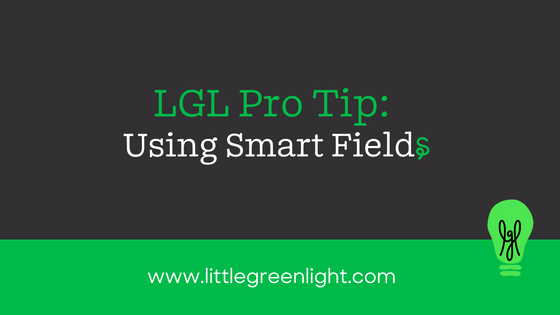Little Green Light is a cloud-based donor management system for fundraisers.
Subscribe to get our latest product updates, best practices and tips to grow your nonprofit.

Smart Fields offer a robust and useful toolset to new and advanced LGL users alike. Getting started using them is not complicated, and their key benefit is that you can “program” them once and then trust them to accurately and quickly pull data into reports and mailings. This gives you flexibility and power, combined with time savings.
A Smart Field is a customizable, calculated field that allows you to pull specific data (in most cases, gifts) into different combinations for use in reports and mailings/emails.
These “types” are more flexible than their names imply, though. Here’s just one example of why: If you create a “First Gift” Smart Field, you can set it to pull the first gift that matches the specific criteria you select. So the “first gift” the Smart Field pulls may be different from the constituent’s actual first gift in your database, yielding a different meaning of “first gift”.
Below are some examples of how Smart Fields can save you time, add consistency to your reporting, and help make the data you can pull into mailings and emails more targeted. The only thing you need to make sure of is that your data is consistent and correct and your gifts are accurately coded.
This Smart Field type may be the most flexible and powerful of all.
A good example of a Total Giving Smart Field is one that sums up just the total of recurring gifts for any given year. Note: This Smart Field can be effective only if all applicable gifts are coded using the gift category of “Recurring”.
Here’s how you would set this up:
With these settings in place, you have a couple of options:
Expanding on the recurring giving scenario, you can imagine that a report might have the “first” recurring gift a donor gave in column C and the “last” recurring gift they gave in column D (where the gift category of “Recurring” is required).
Here you can use the First Gift Smart Field to add language to a mailing/email such as, “Thank you for the recurring gift you have given to our organization as of X,” where the Smart Field pulls in the first recurring gift date of X.
Conversely, if someone has lapsed as a recurring donor, you could use a “Last Gift” Smart Field to pull data in such as, “We ask that you consider re-starting your recurring gift with our organization. Our records indicate your last recurring gift occurred on Y,” where Y is the date of the last recurring gift.
A Largest Gift Smart Field can be useful when you want to keep track of annual giving versus gifts to such initiatives as a capital campaign happening concurrently. In that scenario, you might need a reporting column and mail/email merge field reflecting the constituent’s largest gift only to the “annual appeal(s)”. This makes it possible not to pull in their largest gift overall, which may be to the capital campaign.
Additional information, including instructions for creating and using Smart Fields, is available in our Knowledge Base.
Conclusion
Because they are so smart and helpful, we wanted to share a few of the benefits of using Smart Fields. As you may have noticed, the powerful ways they allow you to pull very specific data into constituent reports and communications can give you more and better options for good stewardship.
Ready to try LGL? Get your first 30 days free. No credit card required.